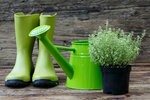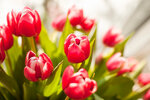

It’s just inevitable here: gardeners get wet. We all have our limits about how wet, how often, and for how long. Even those who try to avoid rain aren’t always spared; sudden, unpredicted little showers mean there probably isn’t a gardener alive in this region who hasn’t been at least damp. The Wicked Witch of the West, who was dissolved by water, definitely wouldn’t have lived long around here.
This time of year, it’s usually raining when we have time to do essential gardening, and sunny when we’re otherwise occupied. Planting tulip bulbs comes to mind. Some gardeners did this a month ago, avant le deluge.
But in my front yard, the tulip planting process can’t start until every single summer and fall flower has faded or been killed by frost. I can’t quite harden my heart enough to kill anything that still has a flower on it, which does make for a disorderly looking garden for a while. This week, it’s finally cleaned up, with apologies to many disturbed spiders, insects and larvae. (The back yard will remain as it is until spring to harbor all their friends and relatives.)
Now those tidy but bare flowerbeds are ready for digging and planting, and of course it’s raining. The forecast for tomorrow is dry, but I won’t be home. So, deep breath, rubber boots, and here I go.
Two hours later . . .
Red tulip bulbs are in the ground, and so are more small early daffodils near the sidewalk. The mailman likes red tulips; little kids get permission to pick the fun-size daffodils.
The digging was easy. The there was no wind, and the rain was steady but soft. I kept my promise to next spring.
The point of this story: it’s not too late for fall planting
You can plant all sorts of bulbs, trees, shrubs and perennials this time of year. The soil is wet and welcoming. For whatever it’s worth, the 14-day forecast doesn’t go below freezing, and there’s more intermittent rain predicted. A young apple tree, a flowering shrub, some garlic cloves, or a clump of daylilies would love to snuggle in to a spacious new home.
Sure you could have planted a month ago, but look around: fall colors are still fabulous, porch pumpkins aren’t rotted yet, and many of us are still eating windowsill-ripened tomatoes.
Two cautions though: First, when planting in the rain, you need the garden version of the chef’s mise en place – all the ingredients prepped and ready: compost, soil amendments, maybe some bark, shovel, and gloves.
Second, you need to be in a patient, Zen state, like the one you muster when you’re trying to pull little weeds in a bed of young carrots without pulling up the carrots. Or when you’re alone for hours with a three-year old who has learned how to talk and can’t stop until she falls asleep.
Planting properly shouldn’t be rushed because you get tired of being wet. Trees, shrubs and flowers don’t want air pockets in the soil. They want their roots to be covered to the level they were in their pots, and they want the soil around them to be firmly tamped down.
Bulbs want to be planted to the right depth, usually three times the size of the bulb – deeper if you want them to last longer, a bit shallower if you want them to multiply. (Then you can dig them up in a year or two and separate and replant the younger bulbs. This works well with daffodils; I’ve never succeeded with tulips.)
Tulips are tricky. Most tulips won’t bloom for more than a couple of years. Darwin tulips are often advertised as perennial, but one honest nursery notes that even they aren’t likely to last more than three years. If you really want perennials, you have to settle for the little species tulips. Also, tulips prefer to be dry during the summer, so if they are in a flowerbed that’s watered regularly, that may also shorten their lives.
So if you want tulips, you have to want them badly enough to plant them nearly every year – even if that means planting them in the rain.
In the movie version of the Wizard of Oz, the Wicked Witch of the West catches fire and dies when Dorothy douses her with water. The conclusion is that it was Dorothy’s kind intentions, not the water, that killed her. In the book, it was the water.
I like the book’s version better. I’d like to think that getting rained on might have a similar effect on us: It might wash away the evil witch tendencies that lurk inside us all. How else can I account for how nice I feel when I come inside after getting drenched?
Jill Severn writes from her home in Olympia, where she grows vegetables, flowers, and a small flock of chickens. She loves conversation among gardeners. Start one by emailing her at jill@theJOLTnews.com
Comments
No comments on this item Please log in to comment by clicking here